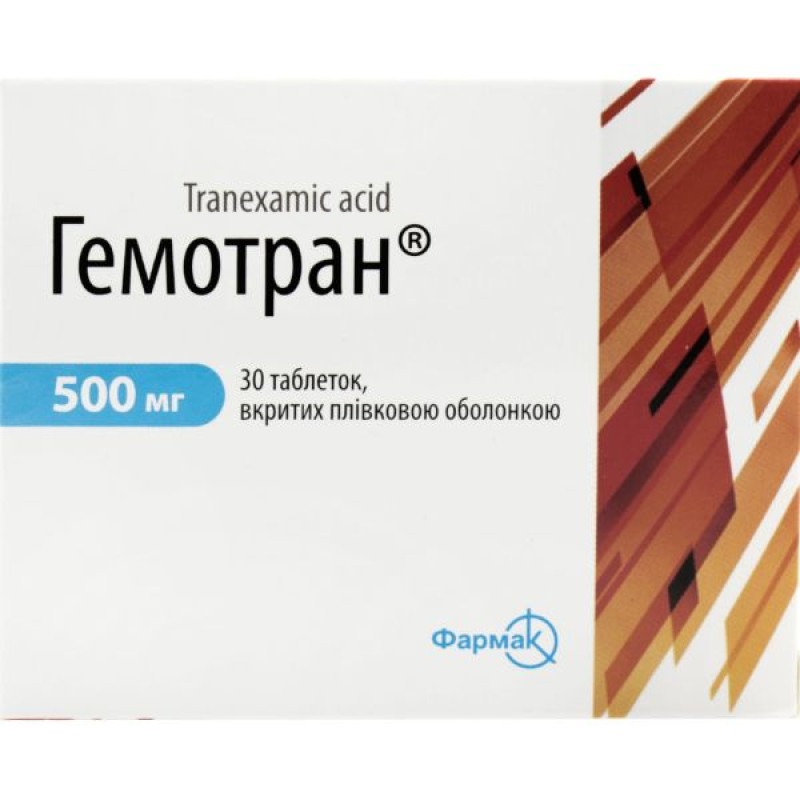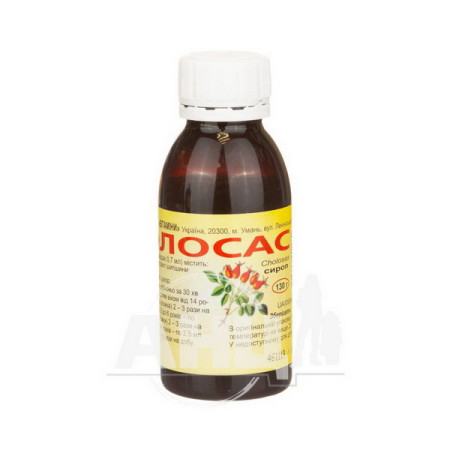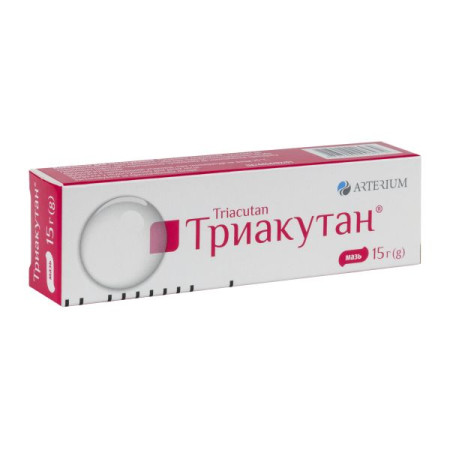Hemotran film-coated tablets 500 mg blister No. 30

Instructions Hemotran film-coated tablets 500 mg blister No. 30
Composition
active ingredient: tranexamic acid;
1 tablet contains tranexamic acid in terms of 100% dry matter – 500 mg;
excipients: povidone, low-substituted hydroxypropylcellulose, hydroxypropylcellulose, colloidal anhydrous silicon dioxide, talc, polyethylene glycol 8000, calcium stearate;
film coating: Opadry White 03 F 180011 (hypromellose, titanium dioxide (E 171), macrogol).
Dosage form
Film-coated tablets.
Main physicochemical properties: oblong tablets, with a biconvex surface, with a score, white or almost white in color, film-coated.
Pharmacotherapeutic group
Antihemorrhagic agents. Fibrinolysis inhibitors. ATC code B02A A02.
Pharmacological properties
Pharmacodynamics
Antifibrinolytic, antiallergic, anti-inflammatory agent. Competitively inhibits plasminogen activator, binds plasmin at higher concentrations. Prolongs prothrombin time. Inhibits the formation of kinins and other peptides involved in inflammatory and allergic reactions.
Pharmacokinetics
When taken orally, 30-50% of the dose is absorbed. Cmax is reached 3 hours after administration and is 8 and 15 mg/l at a dosage of 1 and 2 g, respectively. The concentration-time curve has a triphasic shape with T ½ in the terminal phase of 2 hours. In the blood, approximately 3% is bound to protein (plasminogen). The initial volume of distribution is 9-12 l.
Easily passes through histohematological barriers, including BBB, placental. The concentration in cerebrospinal fluid is 1/10 of the plasma. It is found in seminal fluid, where it inhibits fibrinolytic activity, but does not affect sperm migration. A small part undergoes biotransformation. The main route of excretion is glomerular filtration. More than 95% (mainly unchanged) is excreted in the urine. The total renal CI is equal to the plasma one. The antifibrinolytic concentration in various tissues is maintained for 17 hours, in plasma - up to 7-8 hours.
Tranexamic acid rapidly penetrates into the synovial fluid and synovial membrane. The same concentration is obtained in the synovial fluid as in the blood serum. The half-life of tranexamic acid is about 3 hours. The concentration of tranexamic acid in the blood is lower than in other tissues. In breast milk, the concentration is about 1/100 of the peak concentration in serum. The concentration of tranexamic acid in the cerebrospinal fluid is about 1/10 of the plasma concentration. The drug penetrates into the intraocular fluid, the concentration is about 1/10 of the plasma concentration.
Elimination: The half-life and elimination half-life are approximately 2 hours. It is excreted by the kidneys, mainly unchanged.
Indication
Bleeding or risk of bleeding with increased fibrinolysis, both generalized (bleeding during prostate surgery and in the postoperative period, hemorrhagic complications of fibrinolytic therapy) and local (uterine, gastrointestinal bleeding, bleeding after prostatectomy or bladder surgery, tonsillectomy, conization of the cervix, tooth extraction in patients with hemophilia). Hereditary angioedema.
Contraindication
Hypersensitivity to tranexamic acid and to the components that make up the drug, severe renal failure, macroscopic hematuria, high risk of thrombosis, thrombophlebitis, myocardial infarction, subarachnoid hemorrhage, active thromboembolic disease, history of venous or arterial thrombosis, acute venous or arterial thrombosis, fibrinolytic states after coagulopathy due to exhaustion, except for excessive activation of the fibrinolytic system in acute severe bleeding, history of seizures; impaired color perception.
Interaction with other medicinal products and other types of interactions
Tranexamic acid is incompatible with urokinase, norepinephrine bitartrate, desoxyepinephrine hydrochloride, metarmin bitartrate, dipyridamole, diazepam. Highly active prothrombin complexes and antifibrinolytic agents, antiinhibitory coagulation complexes should not be used simultaneously with tranexamic acid. The combination of chlorpromazine and tranexamic acid should be avoided in patients with subarachnoid hemorrhage: this may lead to cerebral vasospasm and cerebral ischemia and, possibly, to a decrease in cerebral blood flow.
Tranexamic acid should be used with caution in patients using oral contraceptives, as the risk of thrombosis is increased.
Application features
In renal failure (depending on the degree of increase in serum creatinine), the dose and number of injections are reduced. In case of hematuria of renal origin (especially in hemophilia), there is a risk of mechanical anuria as a result of clot formation in the ureters. Cases of venous and arterial thrombosis or thromboembolism have been reported in patients taking tranexamic acid. In addition, cases of occlusion of the central retinal artery and central retinal vein have been reported. Patients taking the drug for more than a few days are recommended to undergo an ophthalmological examination, including visual acuity, color vision, fundus, and visual field.
Patients with thromboembolic disease may be at increased risk of venous or arterial thrombosis.
Tranexamic acid should not be taken concomitantly with Factor IX complex or anti-inhibitor coagulation complexes, as the risk of thrombosis may be increased.
The use of tranexamic acid in cases of increased fibrinolysis due to disseminated intravascular coagulation is not recommended.
Tranexamic acid was detected in semen at fibrinolytic concentrations but did not affect sperm motility. Clinical studies have shown no effect on fertility.
Patients with irregular menstrual bleeding should not use tranexamic acid until the cause of the bleeding is determined. If tranexamic acid does not reduce the intensity of menstrual bleeding, alternative treatment should be considered.
Ability to influence reaction speed when driving vehicles or other mechanisms
While using the drug, you should refrain from driving or working with complex mechanisms.
Use during pregnancy or breastfeeding
Tranexamic acid crosses the placenta and into breast milk. Safety studies of the drug during pregnancy have not been conducted, so during this period the drug can be prescribed only when the expected benefit to the pregnant woman outweighs the potential risk to the fetus. If necessary, the drug should be discontinued.
Method of administration and doses
Adults are prescribed the drug orally, regardless of meals.
Local fibrinolysis: recommended dose is 1-1.5 g 2-3 times a day.
Prostatectomy: for the prevention and treatment of hemorrhages in patients at increased risk before or after surgery, tranexamic acid is prescribed as an injection, after which it is prescribed as tablets of 1 g (2 tablets of 500 mg) 3-4 times a day until the disappearance of macroscopic hematuria.
Menorrhagia: the recommended dose is 2 tablets of 500 mg 3 times a day, for no more than 4 days. In case of prolonged menstrual bleeding, the dose is increased, not exceeding the maximum dose (8 tablets of 500 mg per day). It is not necessary to start treatment with the drug before the onset of menstrual bleeding.
Nosebleeds: for periodic bleeding, 2 tablets of 500 mg are prescribed 3 times a day for 7 days.
Cervical conization: 3 tablets of 500 mg 3 times a day are prescribed for a period of up to 12 days.
Post-traumatic hemiplegia: 2 tablets of 500 mg 3 times a day.
Tooth extraction in patients with hemophilia: The recommended dose is 25 mg/kg of tranexamic acid orally every 8 hours, starting 1 day before surgery and continuing for 2-8 days after surgery.
Hereditary angioedema: Some patients who are aware of the course of exacerbations of the disease usually need 2-3 tablets of 500 mg 2-3 times a day for several days. Other patients should take the drug at the same dose for a long time, depending on the course of the disease.
Impaired renal excretory function: dose adjustment is necessary for patients with mild to moderate renal insufficiency.
Children: prescribed for children aged 12 years and older at a dose of 20-25 mg/kg. The duration of treatment is usually 2-8 days.
Elderly patients: in the absence of impaired renal excretory function, dose adjustment is not required.
Patients with renal insufficiency: the dose should be adjusted according to the plasma creatinine level.
| Plasma creatinine | Dosage |
| 120-250 μmol/L | 15 mg/kg 2 times a day |
| 250-500 μmol/L | 15 mg/kg once daily |
Children
Do not use in children under 12 years of age.
Overdose
Symptoms: nausea, vomiting, abdominal pain, orthostatic hypotension.
Treatment: use of symptomatic therapy.
Adverse reactions
On the part of the digestive tract: nausea, vomiting, heartburn, diarrhea, abdominal pain, decreased appetite.
Skin and subcutaneous tissue disorders: rash, itching, urticaria.
Nervous system: drowsiness, dizziness, color vision impairment, visual impairment, seizures, congestive retinopathy, retinal vein/artery occlusion.
Immune system disorders: hypersensitivity reactions, including anaphylaxis.
Vascular disorders: thrombosis, thromboembolism, arterial hypotension.
Renal: acute renal cortical necrosis.
Expiration date
2 years.
Do not use the drug after the expiration date indicated on the package.
Storage conditions
Store in the original packaging at a temperature not exceeding 25 °C.
Keep out of reach of children.
Packaging
10 tablets in a blister. 3 blisters in a pack.
Vacation category
According to the recipe.
Producer
JSC "Farmak".
Location of the manufacturer and its business address
Ukraine, 04080, Kyiv, Kyrylivska St., 74.
There are no reviews for this product.
There are no reviews for this product, be the first to leave your review.
No questions about this product, be the first and ask your question.










